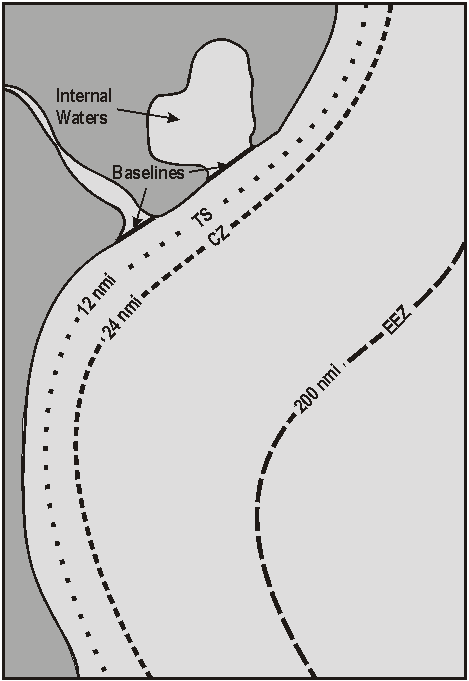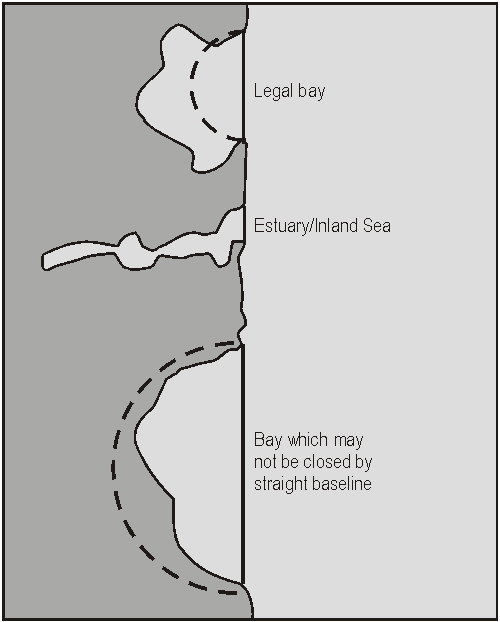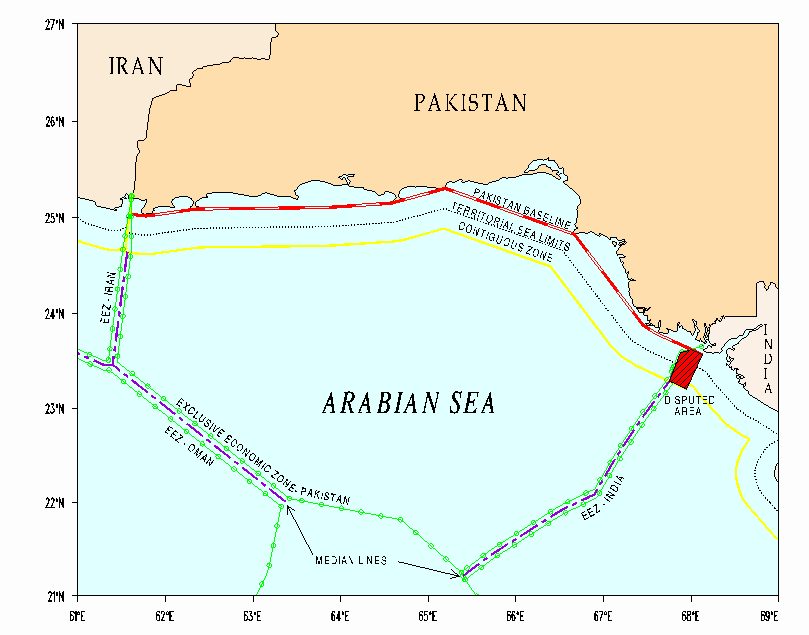
Harold D. Palmer, Senior Marine Scientist
Lorin Pruett, Senior Marine GIS Analyst
Under the United Nations Law of the Sea, coastal states are provided with legal Articles which determine the manner in which boundaries and limits in the seas may be drawn. Maritime activity such as mineral exploration, research, mining, laying of cables and pipelines, transit and other operations occurring within these boundaries come under the jurisdiction of the coastal state. At present, there is no central source of information to display and explain the various boundaries. This paper describes the development of a Global Maritime Boundary Database which is critical in the planning of maritime activities.
The establishment of a boundary on land is quite straightforward - build a fence, a wall, a road, or a ditch and declare that access to or occupation of the terrain on "your" side is subject to your discretion. This works well when distinct points on the ground may serve as markers from which your boundary lines originate. A "property owner" with the means to control access may thus regulate activities within that region. This owner hopes that another state acknowledges such claims and any question about their location and associated or implied rights can be settled amicably. There are other means of adjudication open to states who may dispute boundaries - one such body is the International Court of Justice which renders decisions affecting boundary delimitation.
The "straightforwardness" of delimitation based upon terrestrial features begins to fail when a body of water becomes part or all of the boundary. A river, lake, estuary , shoreline or other fluid body complicates delimitation. Such features are dynamic and may change within short periods of time, leading to revised interpretations of geographic location upon which boundaries are based. Beyond the sight of land, reasonably accurate positioning is achieved through satellite positioning systems such as the Global Positioning System (GPS) or similar geodetic locational methods In the sea the delimitation of maritime jurisdiction is further compounded by the selection of the datum from which boundaries are derived. There are at least six different vertical references (hydrographic datums) employed to define the basis for drawing maritime boundaries. While such issues are beyond the scope of this paper, we will examine the traditional maritime boundaries invoked by coastal states and the application of Geographic Information Systems (GIS) to facilitate display and interpretation of coastal state claims. A thorough review of maritime boundary issues will be found in Lathrop (1997).
Coastal states draw maritime boundaries to delimit areas for juridical purposes. The declaration of a baseline is the basis for establishing the geographic reference from which other maritime limits are drawn.. Specific protocols under the Articles of the United Nations Convention on the Law of the Sea (UNCLOS) describe the conditions under which a state may establish such baselines, using the shoreline (mean low water), a straight baseline established under UNCLOS Articles, or a combination of both. The traditional zones of a Territorial Sea (usually 12 nautical miles), the insertion of a Contiguous Zone (additional 12 nautical miles ) and the claim of an Exclusive Economic Zone (EEZ, usually 200 nautical miles [nmi]) are shown in Figure 1. Since the fundamental reference to such boundaries is the baseline, the UNCLOS has declared formulae to determine the length and direction of lines other than the curvilinear "shoreline" which is based upon various vertical datums. An excellent summary of the UNCLOS, complete with commentary and interpretation, may be found in a supplement to the U.S. State Department's "Dispatch" U.S. GPO, 1995). Standard references for specific countries and their claims will be found in Prescott (1985), Charney and Alexander (1993) and the ongoing New Directions in the Law of the Sea Series (Oceana).

Figure 1: Primary maritime boundaries drawn from baselines.
TS=Territorial Sea, CZ=ContiguousZone, EEZ=Exclusive Economic Zone.
Continental Shelf boundaries may extend seaward of the EEZ limit.
These constructs, termed "straight baselines," enclose river mouths, irregular embayments of a specific size, and other features where "internal waters" may be claimed. Under Article 7 of the UNCLOS, straight baselines may be constructed only in a) localities where the coastline is deeply indented and cut into or, b) where a fringe of islands lies in the immediate vicinity of the coast. Two conditions regarding the width of embayments and permissible baselines appear in Figure 2.

Figure 2: Straight baseline construction according to Article 10 of the UNCLOS.
The depth of indentation of an embayment must be greater
than one-half the length of the baseline closing the bay.
Another maritime boundary of growing significance may be derived from geographic references other than the baseline. Delimitation of the Continental Shelf Regime employs bathymetric, geomorphic and geologic datums which also require geospatial documentation. Whereas the EEZ is established to allow of control of activities on the sea's surface and in the water column, the Continental Shelf claims are directed toward resources, mineral and living, which lie on and under the seafloor. These shelf claims can extend for significant distances beyond the 200 nautical mile EEZ and encompass enormous tracts of the seafloor. There are several formulae which may be invoked in the designation of continental shelf boundaries. Details are explained in a publication of the UN's Division for Ocean Affairs (UN, 1993). Finally, there are claims on the seafloor under high seas regions which lie beyond any coastal state's claims. These are included under the United Nations "International Seabed Authority" and convey rights to deep-sea mining in international waters.
Maritime boundaries established under either the UNCLOS protocols or unilateral coastal state claims are dependent upon some geospatial reference which (initially) provides a point on the earth's surface as the fixed basis for a claim. In the case of the low water datum or straight lines for baseline construction, such locations depend upon a variety of hydrographic determinations referenced to their vertical datum. For Continental Shelf boundary constructions (and for other boundaries far from shore), oceanographic and geophysical surveys and their attendant positioning capabilities under such systems as the GPS determine the accuracy of geospatial coordinates employed in establishing boundary claims.
A Geographic Information System (GIS) is a computerized data management system for the capture, storage, retrieval, analysis and display of spatial data. The basic elements of a GIS are points, lines, and polygons. They permit the display of two-dimensional presentations of "attributes'" - descriptions of features and data which characterize a particular data set.
To manipulate spatial data in a GIS mode, the computer needs three things:
For maritime boundaries, these conditions are met by the declarations of the coastal state in applying for recognition of its jurisdiction. The basic features are the points: these may be shoreline low water (or other datum) points, geographic features serving as points (headlands, islands, etc.), "turning points" for straight baseline constructions, end-points for a line, or corners for a polygon. After these elements are entered in the GIS database, attributes are applied which "label" the feature and provide background information on the nature of that feature. Finally, the GIS relates the feature (point, line or polygon) to neighboring features (coastline, similar features, different features, etc.).
Maritime boundary information is available from a variety of sources, including the United Nations, various State Departments or their equivalents in coastal states, academic institutions and private databases. Yet nowhere are all the data, and especially their attributes providing essential background information, available in a GIS database. Marine enterprises benefit from, and depend upon, information regarding the juridical claims presented by coastal states. Under such claims, stipulations addressing constraints to various activities under UNCLOS protocols or coastal state declarations become integral elements in planning offshore developments which will both justify investor's support and assure unimpeded execution of proposed offshore endeavors.
MRJ Technology Solutions has developed, and will shortly offer, a Global Maritime Boundary Database (GMBD) which will contain information on current maritime delimitation and offer periodic updates to changes in coastal state's claims to jurisdiction over offshore regions. An example of such a database entry is provided in Figure 3. Here the claims of Pakistan have been displayed and the variety and nature of UNCLOS claims as well as indigenous claims and the location of a disputed area are presented in a database format.

|
|
||||||||||||||||||||||||||||||||||||||||||||||||||||||||||||||||||||||||||||
| |||||||||||||||||||||||||||||||||||||||||||||||||||||||||||||||||||||||||||||
Figure 3: Example of GMBD entry.
Attribute data describe construction of maritime limits and
sources of information
At present the GMBD boundary data are derived from numerous sources. We have employed World Vector Shoreline (WVS) at the scale of 1:250,000 as the reference for boundaries. Due to the small scale of the WVS as compared to the larger scale of approach and harbor charts (1:100,000 to 1:25,000) from which listed boundary coordinates are derived, a review has been made of nautical charts and supplementary sources of hydrographic data to ensure islands, reefs, rocks and shoals were represented in WVS. Buffers constructed from such data provide the basis for graphic presentation of boundaries in the GMBD.
In smaller seas such as the Mediterranean and Caribbean, a state's claim to an EEZ extending the full 200 nmi creates overlaps. In addition, with the increasing capability to exploit natural resources on and under the deep seabed at least 33 countries can, under Article 76 of the UNCLOS, draw limits to their continental shelves which extend beyond their respective EEZ's.
Where these claims, and those for EEZ's, overlap a "median line" (or "equidistant line") can become the agreed boundary. MRJ Technology Solutions has developed a program using Avenue scripts developed in Esri's Arcview GIS software to create a global set of median lines on the surface of a spheroid. The program does not require the user to pre-select controlling points from the baselines; the program selects them directly from the shoreline (any scale source) and/or straight baseline data. The user can indicate the desired accuracy by adjusting the step size and tolerance.
Questions of scale and projection enter into an assessment of accuracy in any GIS. In the case of maritime boundaries, this is especially true since data derived from nautical charts suffer from factors such as line width on the chart and variations in chart datum between countries (hence an discrepancy in buffering). Mercator projection is the common basis for mariners, and errors in line length and in true distances increase cumulatively as distance from the equator increases. The basis and assumptions for all data in the GMBD are carefully enumerated for the user and sources of error are identified as appropriate to each entry. Lathrop (1997) and Vanicek (1998) review some of these pitfalls in their reviews of delimitation errors.
Maritime boundaries affect all those engaged in offshore activities, from extractive industries such as fisheries and petroleum to the conduct or marine scientific research (MSR). The latter is of special concern to the academic community since formal permissions for obtaining samples from the water column or the seafloor may require not only permission from the coastal state but participation on-board ship by coastal state scientists. The GMBD is designed to provide those engaged in maritime activities with a planning tool which presents the geographic extent of real or perceived jurisdictions of coastal states. It further identifies those regions in which boundaries are in dispute, overlap or are otherwise unresolved. For example, numerous boundary issues have been raised as a result of fisheries disputes, and in many cases the fisheries agreements and their limits and conditions (usually quotas, restrictions in gear and vessels size or seasonal constraints) are incorporated in the GMBD.
No maritime activity should be anticipated or undertaken without cognizance of boundaries claimed by coastal states. Coastal states are entitled to control, regulate, deny, or in the case of MSR participate in, marine activity occurring in waters which they may rightly claim under ratification of the UNCLOS. As the legal framework of maritime boundaries evolves, the GMDB will provide current status and locational information in a GIS context useful to a variety of users.
The development and maintenance of the GMBD has been, and remains, an arduous task. Its success depends on the dedication of the GIS staff of MRJ Technology Solutions. Without the support of Kurt Christensen, Laura Crenshaw, Tracie Penman and Joe Cimino this effort could not be sustained.
REFERENCES
Charney, J.I. and Alexander, L.M., 1993, International Maritime Boundaries. 3 vols., American Society of International Law (Dordrecht, Boston, London: Martinus Nuhoff Publishers).
Lathrop, C., 1997, "The technical aspects of international maritime boundary delimitation, depiction and recovery. Ocean Development and International Law, Vol. 28, pp. 167-197.
Oceana Publications, ongoing series, New Directions in the Law of the Sea. Ed. K.R. Simmonds (London, Rome, New York: Oceana Publications, Inc.).
Prescott, J. R. V., 1985, The Maritime Political Boundaries of the World.London: (Methuen and Co., Ltd).
United Nations, 1993, The law of the Sea: Definition of the Continental Shelf. Division for Ocean Affairs and the Law of the Sea. (New York: Office of Legal Affairs, United Nations), 50 p.
U.S. Government Printing Office, 1995, Dispatch: Law of the Sea Convention: Letters of Transmittal and Submittal and Commentary. U.S. Department of State, Office of Public Communications, Bureau of Public Affairs, Vol. 6, Supplement No. 1, ed. C. Macdonald (Washington, D.C.) 54 p.
Dr. Harold D. Palmer, Senior Marine Scientist, MRJ Technology Solutions, 10560 Arrowhead Dr. Fairfax, VA 22030, USA, (703) 277-1239, fax (703) 385-4637, hpalmer@mrj.com or MaritimeBoundaries@mrj.com
Mr. Lorin T. Pruett, Senior Marine GIS Analyst, MRJ Technology Solutions, 10560 Arrowhead Dr., Fairfax, VA 22030, USA (703) 277-1879 fax (703) 385-4637, lpruett@mrj.com
Mr. Kurt K. Christensen, Engineering Specialist, MRJ Technology Solutions, 10560 Arrowhead Dr., Fairfax, VA 22030, USA (703) 277-1879 fax (703) 385-4637, kchrist1@mrj.com